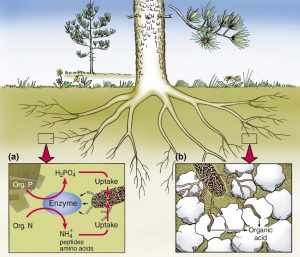Ectomycorrhizas
UWL Website bioweb.uwlax.edu
The main structural features are the Hartig net, mantle and extraradical mycelium.
The Hartig net is seen to be a structure with the properties of transfer cells, in which effective exchange of solutes occurs between symbionts.
Extraradical mycelium are the structure primarily involved in exploration and exploitation of soil.
Ectomycorrhizae forms relationships with birch, oak, myrtle, beech, willow, spruce, pine and fir. It forms an extensive hyphal network, which is frequently visible to the eye and is characteristic of this organism
Some of the species found in ectomycorrhizal product blends include Rhizopogon villosulus, R. luteolus, R. amylopogon, R. fulvigleba, Pisolithus tinctorius, Schleorderma cepa, and S. citrinum.
Ectomycorrhizal fungi do not penetrate their host’s cell walls. Instead, they form an entirely intercellular interface, consisting of highly branched hyphae forming a network between epidermal and cortical root cells, known as the Hartig Net.
Ectomycorrhizas are further differentiated from other mycorrhizas by the formation of a dense hyphal sheath, known as the mantle, surrounding the root surface. This sheathing mantle can be up to 40 mm thick, with hyphae extending up to several centimeters into the surrounding soil. This hyphal network aids in water and nutrient uptake often helping the host plant to survive adverse conditions, and in exchange, the fungal symbiont is provided with access to carbohydrates.
The extramatrical mycelia of ectomycorrhizas function as transport structures. They are often able to spread great distances to maintain a large contact area with the soil. Some studies have even shown a relationship between nutrient transport rates and the degree of rhizomorph organization.
The hyphae extending outward into the soil from one ectomycorrhiza can serve as a source of EcM inoculation to other nearby plants. This can lead to the formation of common mycorrhizal networks (CMNs), which experiments have shown to culminate in the sharing of carbon and nutrients among the connected host plants.
Many ectomycorrhizal fungi are known to rely upon mammals for the dispersal of spores, particularly those fungi with hypogeous fruiting bodies. These mammals are often drawn to hypogeous fruiting bodies because they are rich in nutrients such as nitrogen, phosphorus, minerals and vitamins.
Agriculture indirectly affects nearby ectomycorrhizal species and habitats, such as increased fertilization decreasing sporocarp production
In commercial forestry, the transplanting of crop trees in new locales often requires an accompanying ectomycorrhizal partner. This is especially true of trees that have a high degree of specificity for their mycobiont, or trees that are being planted far from their native habitat among fungal species. This has been shown time and again in plantings involving ectomycorrhizal trees. Mass planting of these species often require human addition of inoculum from native EcM fungi in order for the trees to prosper.
After being added to various soil mixtures, the mutualism can begin as seedlings are grown in nurseries or plantations. This is already becoming common, and there are many companies that are beginning to sell a variety of mycorrhizal inoculum. Pisolithus tinctorius is widespread among the EcM fungi.
Ectomycorrhizal fungi are susceptible to heavy metal contamination. However, there seems to be widespread heavy metal tolerance in these fungi, with many species having the ability to colonize soils both with and without high heavy metal content.
Another problem faced by many plants is high soil salinity. One study shows that some EcM fungi are capable of improving salt tolerance in a species of poplar by altering leaf physiology. Though the symbiotic contact takes place at the root interface, the fungus was able to alter such leaf traits as concentration of nutrients and phytohormones.
EcM communities are affected by increased temperatures, which can either slow respiration, or alternatively improve colonization of host plants. They are also affected by drought, but do provide protection, and improve water uptake ability of the roots.
It is apparent that Ectomycorrhizal communities influence forest productivity and recovery. In europe there has been a concerning decline in many species of Ecm fungi, gaining attention of conservation communities. This loss is attributed to the conversion of forests to other uses, pollution, and the acidification of forest soils.
